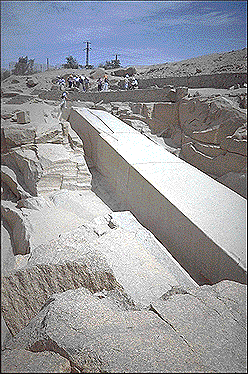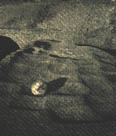
| www.findstone.com | ||
| Findstone Home >> Library >> Country Specific Data | ||
Hard Stone Quarries
To see a chart with different types of
stones and their properties, click
here. 
As one would expect, extracting materials from
hard stone quarries was significantly more difficult for ancient Egyptians than
from their soft stone counterparts. The tools necessary to remove and shape
blocks from bedrock had to be as strong or stronger than the rock being cut, and
for this reason metal tools could not be used. Instead, workers would chip away
at hard stone with tools made from comparatively harder types of stone. Such is
the case with the extraction of granite, where dolerite balls were pounded
against the rock's surface in order to cut into it.
Granite was used as a building
material by the Egyptians throughout most of the dynastic period. Djoser's
funerary complex at Saqqara marks the first time it was used extensively, but by
the 18th and 19th dynasties it had become the third most used architectural
material after limestone and sandstone. Initially, builders obtained granite by
simply working large, loose boulders that dotted the outskirts of the upper Nile
valley near Aswan. Obviously, the supply of these boulders quickly ran out as
architects began to fully utilize the stone for its structural and aesthetic
properties. It became apparent that granite would have to be quarried from
bedrock, and no place could provide this more easily or abundantly than the
source of the early boulders, Aswan. Marked by its magnificent cataracts(the
northernmost in Egypt), the Aswan region would be able to supply ancient
builders with all the granite they could ever use.
In order to see how granite was extracted from
Aswan by the ancient Egyptians, it is best to look at abandoned quarries such as
the famous unfinished obelisk. This massive site was originally intended to
become the source for the largest obelisk ever made (when erected, it would have
been 42 meters high). Work on this colossal feat was halted late in its
development because of the discovery of cracks in the rock that would threaten
the obelisk's structural integrity. Though its size  was
abnormal, it is evident from remains at the site that the unfinished obelisk was
cut out of bedrock using the method suspected to have been implemented at other
granite quarries. Workers would cut away a trench of about 75 cms all the way
around the block intended for removal by pounding at the surrounding bedrock
with the dolerite balls mentioned previously. Each worker would have his own
quadrant in which he would chip the rock in one corner until told to change
position and work another corner. After the trench had reached its desired depth
(a bit deeper than the depth of the block being quarried), workers had to cut
out enough rock from underneath the block so that it could be broken free by
massive wooden levers.
was
abnormal, it is evident from remains at the site that the unfinished obelisk was
cut out of bedrock using the method suspected to have been implemented at other
granite quarries. Workers would cut away a trench of about 75 cms all the way
around the block intended for removal by pounding at the surrounding bedrock
with the dolerite balls mentioned previously. Each worker would have his own
quadrant in which he would chip the rock in one corner until told to change
position and work another corner. After the trench had reached its desired depth
(a bit deeper than the depth of the block being quarried), workers had to cut
out enough rock from underneath the block so that it could be broken free by
massive wooden levers.
The incessant noise of dolerite balls pounding, knee damage due to kneeling all
the time, and other factors led to what would seem to be a rather miserable
existence for quarry workers. It was not necessary for these to be skilled
laborers, so it is often theorized that prisoners of war or other people in
unfortunate situations did most of the work. Most studies of ancient Egyptian
quarrying techniques for hard stone have focused on granite, but we know that
quartzite at least was not obtained by pounding around it with dolerite balls.
Instead of having relatively vertical walled trenches, quarries of this rock
featured walls stepped in one foot increments. These steps were cut by creating
a crack in the rock with huge diorite chisels and then breaking off the
remainder .
Top image copyright 1991 The University of Memphis
Bottom image (Dolerite pounding ball found in situ at Aswan) From Ancient Egyptian Masonry
|| Next Article || Library List || Home || Report Brokenlink ||